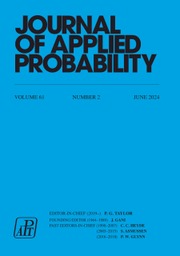Crossref Citations
This article has been cited by the following publications. This list is generated based on data provided by Crossref.
Barlevy, Gadi
2003.
Estimating Models of on-the-Job Search Using Record Statistics.
SSRN Electronic Journal ,
Barlevy, Gadi
and
Nagaraja, H.N.
2005.
Characterizations in a Random Record Model with a Non-identically Distributed Initial Record.
SSRN Electronic Journal,
Barlevy, Gadi
and
Nagaraja, H. N.
2006.
Characterizations in a random record model with a nonidentically distributed initial record.
Journal of Applied Probability,
Vol. 43,
Issue. 04,
p.
1119.
BARLEVY, GADI
2008.
Identification of Search Models using Record Statistics.
Review of Economic Studies,
Vol. 75,
Issue. 1,
p.
29.
Barlevy, Gadi
and
Nagaraja, H.N.
2010.
Estimating mobility rates in search models with initial condition problems.
Review of Economic Dynamics,
Vol. 13,
Issue. 4,
p.
780.
Barakat, H.M.
2012.
Asymptotic behavior of the record value sequence.
Journal of the Korean Statistical Society,
Vol. 41,
Issue. 3,
p.
369.
Shrahili, Mansour
Kayid, Mohamed
and
Khan, Abdul Rauf
2022.
Characterizations of Probability Distribution by Some Sequential Relative Reliability Measures: An Application of Completeness in a Hilbert Space.
Journal of Function Spaces,
Vol. 2022,
Issue. ,
p.
1.
Khosravi Tanak, Ali
Fashandi, M.
Ahmadi, J.
and
Najafi, M.
2024.
On the Mean Residual of Records in the Geometric Random Record Model.
Journal of Statistical Sciences,
Vol. 17,
Issue. 2,
p.
0.

